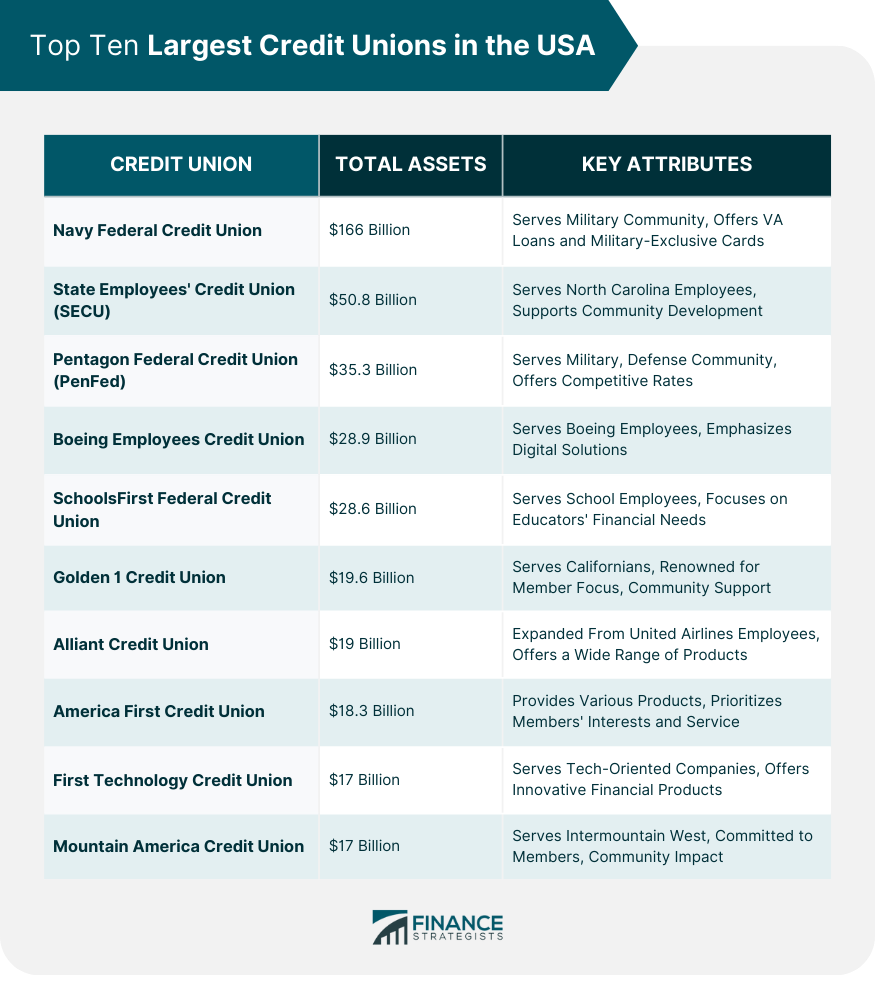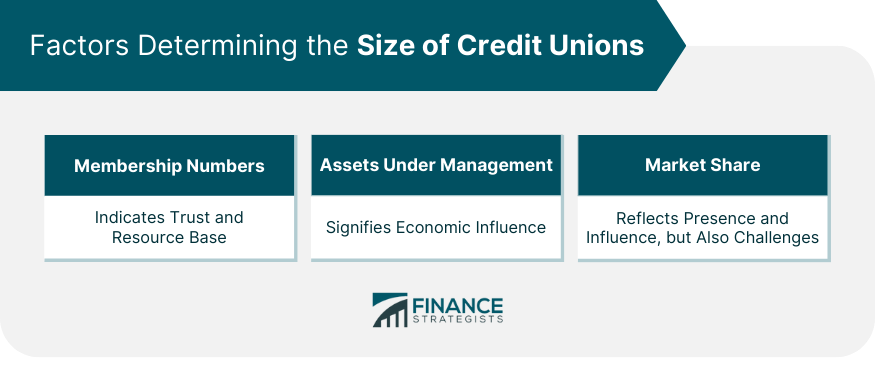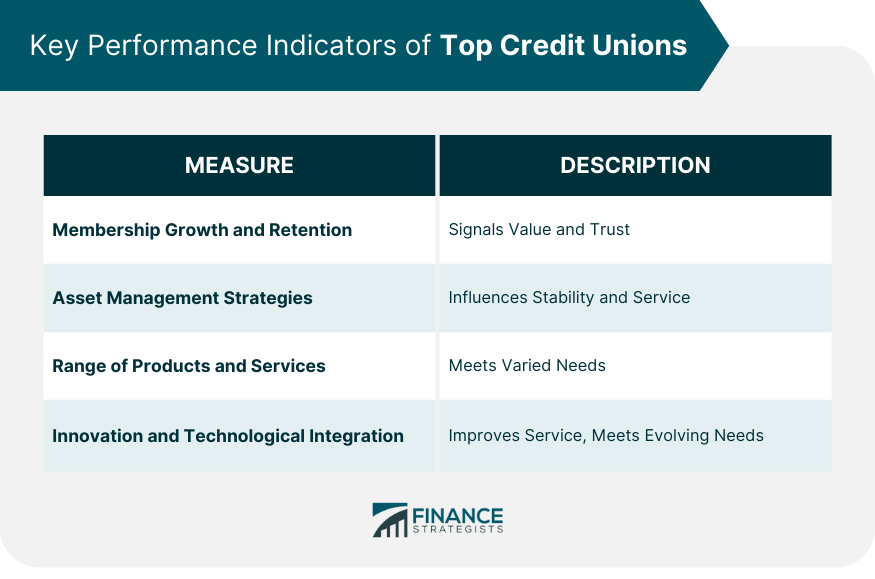Credit unions are not-for-profit financial institutions owned by their members. Unlike banks that generate profits for shareholders, credit unions return surplus income to their members in the form of reduced fees, higher savings rates, and lower loan rates. Membership is typically based on common characteristics such as location, employer, or membership in a group or association. Diving deeper, credit unions operate under a cooperative model. That means every member, regardless of their deposit size or loan amount, has an equal say in the credit union's governance. This structure empowers each member and reinforces the community-centered nature of credit unions. As the largest credit union in the US with over $166 billion in total assets, Navy Federal Credit Union is a prime example of the impact these institutions can have. Originally established to serve members of the Navy, it has since expanded to serve all branches of the military, the Department of Defense, veterans, and their families. Known for their excellent customer service, Navy Federal provides a comprehensive range of banking services from mortgages to credit cards and retirement planning. The success of Navy Federal is built on its commitment to the military community. It offers specialized services such as VA loans and military-exclusive credit cards, reinforcing its bond with its members and establishing itself as a reliable financial partner for the military community. The State Employees' Credit Union (SECU), with $50.8 billion in assets, serves employees of the state of North Carolina. It has made its mark through the provision of a wide array of financial services, such as loans, insurance, investment advice, and estate planning. Additionally, SECU places an emphasis on community development, with initiatives like affordable housing programs and scholarship opportunities. SECU's strength lies in its connection to its community. By focusing on the needs of state employees and their families, SECU has built a loyal membership base. It has continually evolved its services to respond to the changing financial needs of its members, reinforcing its position as a vital resource for its community. Pentagon Federal Credit Union, often known as PenFed, holds $35.3 billion in assets. It serves members of the military, defense community, and their families. However, PenFed has expanded its field of membership to include anyone who is a member of several eligible associations and organizations. PenFed offers a variety of products and services, such as checking and savings accounts, credit cards, loans, and wealth management services. Its success stems from its commitment to providing excellent service and competitive rates to its members. Whether it's helping members buy a home or plan for retirement, PenFed continually works to enhance the financial wellbeing of its members. Boeing Employees Credit Union, with $28.9 billion in assets, was established to serve the employees of The Boeing Company. Today, however, it welcomes members from a variety of employers and organizations. Offering an array of financial products, from loans and checking accounts to investment services, it has proven to be a steadfast resource for its members. Notably, the credit union’s commitment to innovation and digital transformation has been key to its growth and success. Through user-friendly mobile banking solutions and online services, it has effectively catered to the evolving needs of its members, earning their trust and loyalty. SchoolsFirst Federal Credit Union, holding $28.6 billion in assets, was founded by school employees for school employees. As the name implies, it primarily serves school staff, from teachers to custodians and their families. SchoolsFirst offers a comprehensive suite of services, including banking, loans, insurance, and retirement planning. With its unwavering dedication to education, SchoolsFirst has formed deep bonds with its members. Its success is hinged upon its ability to understand and cater to the unique financial needs of educators, positioning itself as a partner in their financial journey. Golden 1 Credit Union, with assets worth $19.6 billion, is one of California's leading credit unions. Serving members across the Golden State, it offers a wide variety of financial services, including checking and savings accounts, loans, credit cards, and insurance. Golden 1's strength lies in its commitment to its members and the communities it serves. With its strong member focus, Golden 1 has developed a reputation for excellent service and community support. Alliant Credit Union, with $19 billion in assets, is one of the largest credit unions in the nation. Though originally established to serve United Airlines employees, it has since expanded its membership eligibility to include numerous organizations and communities. Alliant offers a broad range of financial products, from loans and credit cards to investment and insurance services. Its commitment to providing superior value and service to its members is the cornerstone of its success. America First Credit Union holds $18.3 billion in assets and has a broad member base across several states. It provides a full suite of financial products, from deposit accounts and loans to insurance and investment services. America First's philosophy of putting members first is evident in its dedication to superior service and its continual efforts to provide the best possible value to its members. First Technology Credit Union, with $17 billion in assets, specializes in serving the needs of technology-oriented companies and their employees. With its tech-savvy focus, First Tech offers a range of innovative financial products tailored to its members' unique needs. It prioritizes using technology to provide convenient and efficient service, exemplifying how credit unions can innovate to better serve their members. Mountain America Credit Union, also with $17 billion in assets, serves members in the Intermountain West region. Mountain America offers a comprehensive range of financial services, including banking, loans, insurance, and retirement planning. It prides itself on its commitment to its members and the communities it serves, demonstrating how credit unions can make a significant impact on a regional level. The size of a credit union is often gauged by its membership numbers. A large membership indicates trust and popularity within the community it serves. However, larger membership doesn't always equate to better service. It's the quality of products and commitment to member satisfaction that often set a credit union apart. More importantly, a significant number of members indicate a broad base of resources for the credit union. The combined savings of members serve as a pool of funds for lending to other members, essentially circulating money within the community and fostering mutual growth and prosperity. Another measure of a credit union's size is its assets under management (AUM). This includes loans, investments, and cash reserves. A high AUM generally means that the credit union has a substantial economic influence and can provide its members with a wide range of services. However, a high AUM doesn't always mean a credit union is successful. The effectiveness of the credit union's management and its ability to generate returns from its assets also play a critical role in its financial health and stability. Prudent management of assets ensures the credit union's longevity and its ability to serve its members effectively. A credit union's market share, or the portion of the market it serves compared to other financial institutions, is another way to gauge its size. A large market share indicates a strong presence and influence in its operating area. It also suggests that the credit union has effectively met its members' needs and is a preferred choice for financial services. Conversely, a large market share can also present challenges. It may invite regulatory scrutiny and require more extensive infrastructure to support its operations. Additionally, a large market share could make a credit union a potential target for cyberattacks, necessitating robust cybersecurity measures. For credit unions, steady membership growth and retention are important indicators of success. They signal that these institutions are providing value, meeting their members' needs, and earning their trust. However, growth isn't merely a numbers game. A credit union's ability to retain members through high-quality service, competitive rates, and innovative products is equally important. A credit union's asset management strategies greatly influence its financial stability and ability to serve its members. These strategies involve how a credit union uses its assets — the savings of its members — to generate income. This may involve providing loans to members, investing in securities, and maintaining cash reserves. A diverse range of financial products and services is essential for credit unions to meet their members' varied needs. These may include savings and checking accounts, credit cards, auto loans, mortgages, investment services, and insurance products. Beyond these, credit unions also provide financial education resources to enhance their members' financial literacy. In an increasingly digital world, innovation and technological integration are crucial for credit unions. These not only improve service delivery but also help credit unions meet the evolving needs of their members. Innovative services may include mobile banking apps, online loan applications, and digital wallets. Credit unions, like all financial institutions, must navigate a complex regulatory landscape. Regulatory compliance and legislative changes present both challenges and opportunities. While they can impose additional costs, they also drive improvements in transparency, accountability, and service quality. For example, credit unions have had to adapt to changes in regulations governing lending practices, capital requirements, and data security. Despite these challenges, credit unions have used these changes as opportunities to enhance their services and strengthen trust with their members. Economic fluctuations and market volatility can impact credit unions' financial performance. In times of economic downturn, credit unions may see an increase in loan defaults. Conversely, in periods of economic growth, they may experience growth in deposits and lending. However, credit unions are uniquely positioned to navigate these challenges due to their cooperative structure and commitment to their members. Their focus on long-term member welfare rather than short-term profits helps them weather economic fluctuations. The rise of digital banking has revolutionized how credit unions operate. Digitalization offers immense opportunities for credit unions, from improving service delivery to expanding access to financial services. At the same time, it presents new challenges, particularly in the area of cybersecurity. As credit unions expand their digital services, they must also invest in robust cybersecurity measures to protect their members' information and their own systems. Credit unions like Pentagon Federal have demonstrated this balance, offering comprehensive digital services while prioritizing cybersecurity to ensure the safety and trust of their members. Credit unions have long played a pivotal role in community development. With their member-owned, cooperative structure, credit unions have a natural inclination toward supporting their local communities. They contribute to community development in several ways, from providing affordable financial services to investing in local projects. For instance, State Employees’ Credit Union’s commitment to affordable housing and education exemplifies credit unions' role in community development. Through their initiatives, they are not only improving the financial well-being of their members but also enhancing the quality of life within their communities. Credit unions also contribute to national and regional economic stability. By providing affordable credit, promoting savings, and offering financial services to underserved communities, credit unions help fuel economic growth and stability. Navy Federal Credit Union, the largest credit union in the US, provides a striking example. With its wide range of financial services and broad membership base, Navy Federal contributes significantly to the economic stability of the military community and the nation at large. Financial literacy and inclusion are key components of credit unions' mission. Through educational programs, workshops, and resources, credit unions help their members and communities understand financial concepts and make informed decisions. SchoolsFirst Federal Credit Union, for instance, prioritizes financial education among its members, reflecting the credit union's commitment to empowering educators and their families. These efforts not only benefit their members but also enhance the overall financial literacy and inclusion in their communities, ultimately contributing to a more equitable financial landscape. Credit unions play a significant role in the American financial landscape, offering an alternative to traditional banking while supporting local communities and national economic stability. They provide valuable financial services to members, including loans, savings accounts, and financial education. The largest credit unions, like the Navy Federal and State Employees' Credit Union, exemplify this impact, servicing vast memberships and managing substantial assets. While size is often associated with the number of members and assets under management, the value offered, member satisfaction, and commitment to community development are crucial success indicators. These credit unions have shown resilience amidst regulatory changes, economic fluctuations, and the growing digitalization of financial services, balancing innovation with robust cybersecurity. Their focus on financial inclusion, literacy, and affordable credit makes credit unions an essential element of an equitable financial system.Overview of Credit Unions
Top Ten Largest Credit Unions in the USA
Navy Federal Credit Union
State Employees' Credit Union
Pentagon Federal Credit Union
Boeing Employees Credit Union
SchoolsFirst Federal Credit Union
Golden 1 Credit Union
Alliant Credit Union
America First Credit Union
First Technology Credit Union
Mountain America Credit Union

Factors Determining the Size of Credit Unions
Membership Numbers
Assets Under Management
Market Share

Key Performance Indicators of Top Credit Unions
Membership Growth and Retention
Asset Management Strategies
Range of Financial Products and Services
Innovation and Technological Integration

Challenges and Opportunities for the Major Credit Unions
Regulatory Compliance and Legislative Changes
Economic Fluctuations and Market Volatility
Digitalization and Cybersecurity
Impact of the Major Credit Unions on the American Financial Landscape
Role in Community Development
Influence on National and Regional Economic Stability
Contributions to Financial Literacy and Inclusion
Bottom Line
Largest Credit Unions in the USA FAQs
Navy Federal Credit Union is the largest credit union in the USA, with over $166 billion in total assets.
Credit unions contribute to the US economy by providing affordable financial services, promoting savings, and investing in local community projects.
Major credit unions face challenges related to regulatory compliance, economic fluctuations, market volatility, and cybersecurity.
Credit unions are leveraging technology to offer digital services such as mobile banking apps, online loan applications, and digital wallets, while enhancing cybersecurity measures.
Credit unions promote financial literacy and inclusion through educational programs, workshops, and resources, helping members and communities make informed financial decisions.
True Tamplin is a published author, public speaker, CEO of UpDigital, and founder of Finance Strategists.
True is a Certified Educator in Personal Finance (CEPF®), author of The Handy Financial Ratios Guide, a member of the Society for Advancing Business Editing and Writing, contributes to his financial education site, Finance Strategists, and has spoken to various financial communities such as the CFA Institute, as well as university students like his Alma mater, Biola University, where he received a bachelor of science in business and data analytics.
To learn more about True, visit his personal website or view his author profiles on Amazon, Nasdaq and Forbes.











